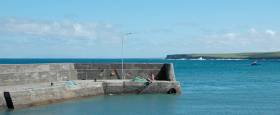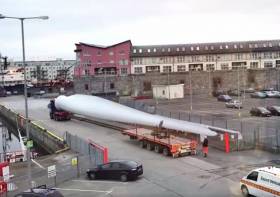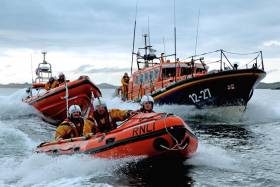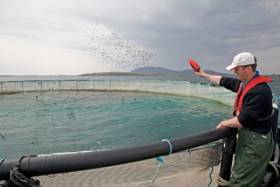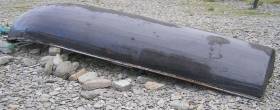Displaying items by tag: Connemara
Connemara & Mayo Drowning Victims Remembered 90 Years On
#ClegganBay - The Irish Times writes on Saturday’s (28 October) memorial service for lives lost in the Cleggan Bay Disaster 90 years ago.
Forty-five men, many of them from Connemara, died after a sudden and severe storm hit a small fleet fishing for herring off the Mayo coast in October 1927.
Descendants of some of those whose lives were taken in the tragedy gathered at a memorial at Lacken pier on Saturday which also paid tribute to diver Michael Heffernan, who was lost in a cave rescue in the region in October 1997.
Masses were also held in Claddaghduff and on Inishbofin, which was home to many of those lost in the incident.
The commemoration had an additional resonance with the loss of five Irish Coast Guard personnel in recent months — the crew of Rescue 116 and volunteer Caitriona Lucas, who was posthumously awarded the State’s highest honour earlier this month.
The Irish Times has much more on the story HERE.
#Windfarm - Giant wind turbine blades seen in Galway Harbour last winter are now in operation in Connemara as part of Ireland’s biggest ever windfarm project.
According to the Connacht Tribune, the Galway Wind Park between Galway Bay and Lough Corrib aims to generate enough energy from its 58 enormous wind turbines to power more than 140,000 homes annually — while offsetting over 220,000 tonnes of carbon emissions.
The news comes just days after the world’s first floating windfarm began generating power for Scotland, as previously reported on Afloat.ie.
Clifden RNLI Name New Inshore Lifeboat ‘Celia Mary’
#RNLI - Clifden RNLI officially named its new D class lifeboat Celia Mary at a special ceremony and service of dedication held yesterday (Saturday 21 October) in the Connemara coastal town.
The honour of handing over the lifeboat and officially naming her went to the donor Peter Ross, husband of the late Celia.
He was accompanied at the ceremony in the Station House Hotel by his family and Celia’s best friend Rea Hollis, who has made a generous donation towards the running costs of Clifden Lifeboat Station.
Celia, who was from East Sussex but was of Irish descent, died three years ago shortly after her 79th birthday. She had always wanted to fund a lifeboat.
A much-loved wife and mother of five children, Celia spent many years living self-sufficiently and keeping cows and sheep. She had a great sense of humour and her kitchen was the focal point of her village.
Her idyllic life came to an end when rheumatoid arthritis took hold. But despite suffering from subsequent ill health, this did not stop her from becoming a respected antiques dealer until what has been described as her indomitable spirit succumbed and she passed away.
During the ceremony, Niamh McCutcheon, a member of the Irish Council of the RNLI, accepted the lifeboat on behalf of the charity from Peter Ross, before handing her over into the care of Clifden Lifeboat Station.
During her address, McCutcheon praised the efforts of all those who supported the work of the station.
“In 2017, Clifden RNLI has been requested to respond to 17 call outs, with a total of 26 launches, bringing 18 people to safety between the three different lifeboats on station here. You cannot put a price on the impact that has on people’s lives, whether they are volunteers or casualties.
“Our lifesavers could not have answered those calls for help without the support they receive from fellow volunteers on the shore: the fundraisers, the launch crew and the station management. In fact the whole of the RNLI depends on those people who represent our charity in the community.”
Lifeboat operations manager John Brittain accepted the lifeboat on behalf of Clifden RNLI ahead of the blessing in a service of dedication led by Father James Ronayne and the Very Reverend Stan Evans. The lifeboat was then officially named by Peter Ross.
Brittain said the event was a special occasion for the lifeboat station, adding that the crew were most grateful to Peter for his generous gift in memory of his wife which had funded the lifeboat.
“Celia always wanted a lifeboat, and now she has one in Clifden,” he said. “While her lifeboat may be a little far from her family, we have been told by her loved ones that Celia, who was of Irish descent, would have revelled in the beauty of Galway, Connemara and the Atlantic coast.”
The D class Celia Mary replaces the Grainne Uaile which served Clifden RNLI for the last 10 years. During that time, the lifeboat launched 62 times, bringing 20 people to safety.
Originally introduced in 1963, the D class has evolved into a highly capable modern lifeboat. It is the workhorse of the RNLI’s fleet and is ideal for working close inshore, near rocks or in shallow water in moderate conditions. It can be righted by the crew if it capsizes and is also part of the RNLI flood rescue team’s fleet of boats.
She comes into her own for searches and rescues in the surf, shallow water and confined locations - often close to cliffs, among rocks and even inside caves.
The RNLI established a lifeboat station in Clifden in early 1988 when a C class lifeboat was put on service for one season’s evaluation. The following year, Clifden RNLI became fully operational as a summer season-only lifeboat station.
In 1997, an Atlantic 21 lifeboat was placed on service and a new boathouse for the lifeboat and a tractor was completed in August 1998. A new D class lifeboat was placed on service in May 1998, and the following year it was joined by a new Atlantic 75 B class lifeboat which remained stationed until June 2013 when it was replaced by the Atlantic 85 named Joyce King.
A crowd of well wishers turned up to see the lifeboat officially named, with a bottle of champagne poured over the side of the boat before it launched at the end of the ceremony.
Among the guests on the platform party were Pearse Hyland, chair of the Lifeboat Management Group, who welcomed guests and opened proceedings, and inshore lifeboat mechanic Andy Bell, who gave a vote of thanks and closed proceedings.
Clifden Lifeboats Rescue Six After Boat Breaks Down Off Connemara Coast
#RNLI - Clifden RNLI’s all-weather and inshore lifeboats were launched shortly before 1pm on Sunday 8 October when a boat with six on board got into difficulty in the Killary Harbour area.
The location of the craft was unclear in the early stages as Clifden’s inshore D class lifeboat was driven by road to Renvyle by driver Neil Gallery and launched at Lettergesh Beach, while the Atlantic 85 inshore lifeboat was launched in Clifden.
The D class lifeboat, crewed by Alan Pryce, Kenneth Flaherty and Kieran Folan, swiftly located the boat and six passengers near Frehill island. They had been out for a fishing trip when their engine failed.
Shortly after, the Atlantic 85 lifeboat crewed by Joe Acton, Owen Hayes and Alvin Bell as the D Class already had the casualty boat under tow.
Four of the six passengers were transferred to the Atlantic 85, Joyce King, and returned to shore at Rossroe from where they had originally set out.
The other two remained onboard their own boat, which was towed back to shore by the D Class lifeboat, Granuaile.
Clifden’s all-weather lifeboat Fisherman’s Friend was also launched to provide additional cover for the rescue operation, but was stood down when the two inshore lifeboats had the situation under control.
Speaking following the callout, Clifden RNLI helm Alan Pryce said: “Luckily the weather conditions were calm at the time and due to our launch site we were able to locate the boat quickly.
“The area is known for its rip currents in the area and can be dangerous so we were glad to have been able to attend and assist as quickly as possible once the alarm was raised."
Pryce added: “We remind anyone planning a trip to sea to always go prepared and respect the water.”
Fire Damage To Connemara Shellfish Research Base
#Connemara - Galway Bay FM reports that a shellfish research centre in Connemara was damaged in a fire earlier this week.
The blaze broke out in a section at the centre in Carna dedicated to studying the control of sea lice in salmon farms.
The facility is part of NUI Galway’s Ryan Institute, the university’s hub for environmental, marine and energy research.
This weekend’s annual Cruinnui na mBad festival (the Gathering of the Boats) in Kinvara in the southeast corner of Galway Bay celebrates a tradition going back far into the mists of time writes W M Nixon. In the old days, it was a matter of necessity that the fleet of working Galway hookers in Connemara should sail up and across the bay, bringing the winter’s consignment of turf to a region where it’s a relatively scarce commodity.
The healthy mixture of commerce and effectively racing under sail, with festivities at the conclusion of a job well done, inevitably developed into a regatta atmosphere, West of Ireland style. So much so, in fact, that these days, the annual Cruinnui na mBad is a major event, which can attract a fleet of up to a hundred boats.
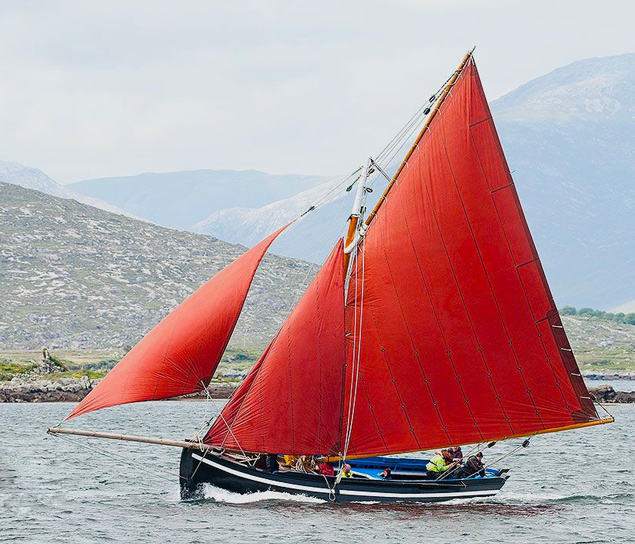 The spirit of Connemara. The Baily family’s classic An Capall making knots under a rugged western coastline
The spirit of Connemara. The Baily family’s classic An Capall making knots under a rugged western coastline
 The Gathering of the Boats – some of the traditional fleet at Kinvara
The Gathering of the Boats – some of the traditional fleet at Kinvara
There’s now something extra to celebrate, as new boats to the traditional designs are being built at a steady rate by Colie Hernon and Peter Connolly and their team in Badoiri na Gaillimh in the Claddagh in Galway, and one of their creations is the central feature in the maritime display in the nearby City of Galway museum.
 Jack Roy, President Irish Sailing (left) with Pierce Purcell of Galway and the traditional gleitog which is the centrepiece of the Maritime Section of Galway Museum.
Jack Roy, President Irish Sailing (left) with Pierce Purcell of Galway and the traditional gleitog which is the centrepiece of the Maritime Section of Galway Museum.
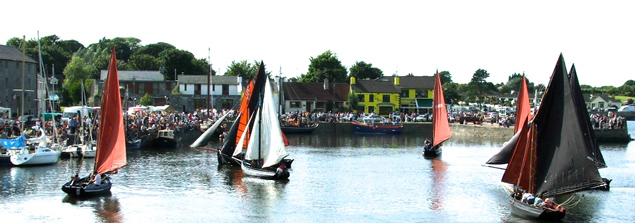 The fleet gathering at hospitable quayside in the heart of Kinvara
The fleet gathering at hospitable quayside in the heart of Kinvara
They are currently working on their seventh boat, a gleitog to be known as the Markeeen Joe. And a fine bit of work she is too, with completion anticipated for the Autumn. But they’ll be well represented by other craft they’ve built in Kinvara on Saturday and Sunday, when good weather is hoped to prevail until at least the middle of Sunday, and there’ll be no lack of proper sailing breezes.
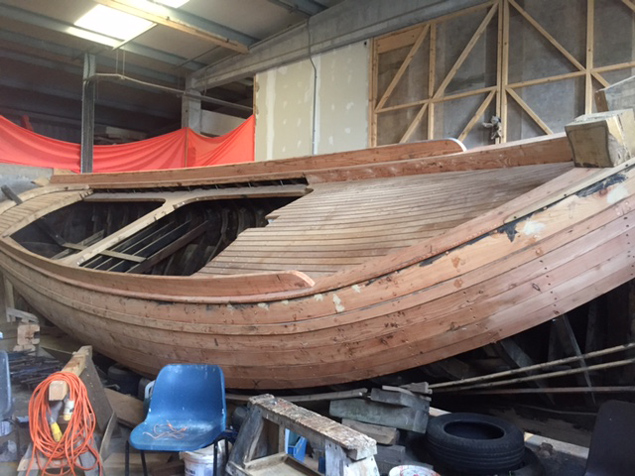 The new Markeen Joe under construction (above and below) in Galway city. Photo: Pierce Purcell
The new Markeen Joe under construction (above and below) in Galway city. Photo: Pierce Purcell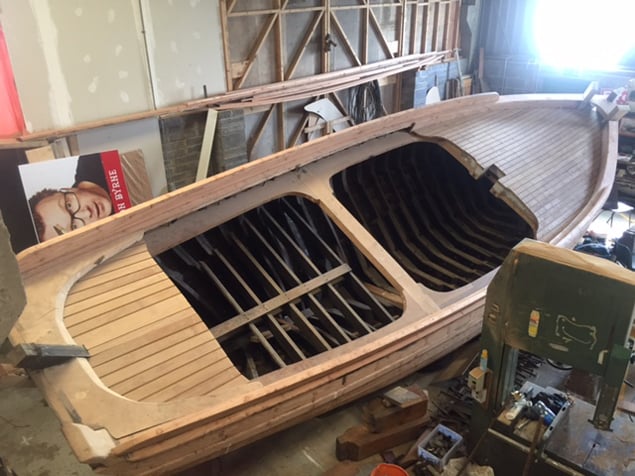
Deployment Of Sampling Nets At Bertraghboy Bay In Connemara
#MarineScience - The Marine Institute has begun deployment of bag nets for a scientific sampling of Bertraghboy Bay and surrounding waters in Connemara.
The nets — checked daily, weather permitting — will extend outward from the coast for some 30 metres, perpendicular to the shoreline. They will be clearly marked with brightly coloured buoys (mainly orange) and labeled with Marine Institute identification.
Deployment was set to begin at and around co-ordinates 53°25’19”N, 9°52’52”W this past Monday 26 June and will continue till Monday 21 August, weather dependent. They are being deployed using a small open boat powered by an outboard engine.
The Marine Institute contact for this survey is Dave Jackson at 091 387 200 or 087 699 3259.
#MarineScience - A new marine research cluster is planned for Connemara incorporating the Údaras na Gaeltachta facility at Pairc na Mara currently under development in Cill Chiaráin, NUI Galway’s Carna Campus Laboratories, and an aquaculture site in Beirtreach Buí near Carna.
The Connemara cluster will form part of a national aquaculture research cluster which includes the Marine Institute facilities at Newport, Co Mayo, with the Beirtreach Buí site touted as “an important part of the State’s marine research infrastructure”.
In 2016, the Marine Institute secured EU Horizon 2020 and Science Foundation Ireland funding for a range of research projects that will be carried out in close collaboration with Marine Institute teams in Newport and Galway as well as researchers at the NUI Galway campus in Carna and the Udaras na Gaeltachta facility at Páirc na Mara.
These research projects will include studies on cleaner fish, which are used to control sea lice and other external parasites; animal welfare; and poly culture of shellfish, fin fish and seaweeds to enhance biodiversity and reduce environmental impacts.
The Marine Institute says it has committed funding to create three jobs to run and maintain the Beirtreach Buí aquaculture research site and provide support to marine research teams and projects.
The Beirtreach Buí site is expected to support a number of research projects in the coming years, including the development of integrated multi-trophic aquaculture, which provides the by-products, including waste, from one aquatic species as inputs (fertilizers, food) for another. This research will be in association with project partners in both Irish third-level institutions and partners from other EU states.
The site will also be used to support a major international project TAPAS, which has received €7 million from the EU under Horizon 2020.
The TAPAS project aims to develop cost-efficient management tools and practices for the European aquaculture sector to investigate the limits to fish farming activity in a location, social interactions, potential environmental impacts and any future risks.
The Marine Institute has applied to the Department of Agriculture, Food and the Marine to amend the licence for the aquaculture site at Beirtreach Buí from a commercial to a research license.
This application to amend the aquaculture licence at Beirtreach Buí will involve a reduction in the size of the site, a decrease in the number of licensed structures, from 48 structures to a maximum of 12 cages and 12 smaller structures made up of a combination of long lines and sentinel cages/passive sampling structures.
The amendment also includes a reduction in the level of fish stock at the site from the current level of 100 tonnes to a maximum of 50 tonnes. The amended license will allow for holding a range of fish, shellfish and seaweed species for research purposes. No commercial production will be licensed at the site.
The site was originally used for farming salmon in the 1980s and, in 2010, the aquaculture licence was amended in order to carry out culture trials on cod in collaboration with NUI Galway and Údaras na Gaeltachta.
In 2013 the site was taken over by the Marine Institute to focus on research work on cod and related studies, including research into natural alternatives for antifouling.
The new research licence application will go to public consultation this week.
#Currach - The first of four new community-built currachs launches from Inishbofin this afternoon (Sunday 30 April), as Galway Bay FM reports.
Young people from the Connemara island have been heavily involved in the traditional boat-building project, funded via the Coca-Cola Thank You Fund for voluntary groups.
And they will see the fruit of their hard work take to the water from the Old Pier at 1pm today, coinciding with the final day of this year’s Inishbofin Arts Festival.
Marine Institute Researcher Runner-Up In EU Photo Contest
#MarinePhoto - A marine researcher at the Marine Institute was recently runner-up in the EU-funded CommBeBiz photography competition with the theme of ‘New Perspectives on the Bio-Economy’.
Tomasz Szumski captured the prize-winning shot ‘Micro Island - Connemara’ when he provided technical and photographic support to Dr Jenny Ronan during sampling and subsampling of the seaweed for the AsMARA project along the Connemara coastline.
AsMARA (arsenic in marine macro algae) is a three-year project funded by the Department of Agriculture, Food and Marine’s Food Institutional Research Measure (FIRM), and is a marine science collaboration between the Marine Institute involving Dr Evin McGovern and NUI Galway’s Dr Dagmar Stengel to research seaweeds found in Ireland and assess their implications for commercial uses.
Over 100 scientists from across nine European countries entered the photo contest to highlight aspects of their research that supports the development of the European bio-economy to reduce the EU’s dependency on fossil resources, and contribute to producing environmentally friendly renewable products that meet our needs for food, materials and energy.
With the ocean representing over 70% of the earth’s surface, living marine resources such as seaweeds can provide a significant contribution to food, energy and bio-based products.
“In Ireland, there is a long tradition of using seaweeds and an increasing international interest in developing this resource into a range of products such as foods, fertilisers, animal feed and cosmetics,” said Szumski.
Through this research, the Marine Institute says it is evaluating the variability in the levels of organic and inorganic forms of arsenic in commercially harvested seaweed species to ensure their safety for such uses as food supplements and cosmetic components. The information generated supports innovation of blue biotechnologies, as well as assisting policy makers in risk management for consumer protection.
The winning photos in the 2017 CommBeBiz photo competition are being exhibited online on European project websites including CommBeBiz and the BioStep Project, as well as in Horizon Magazine, the European Commission’s research and innovation journal.
Entries for the 2018 edition will open on Monday 1 May.




























